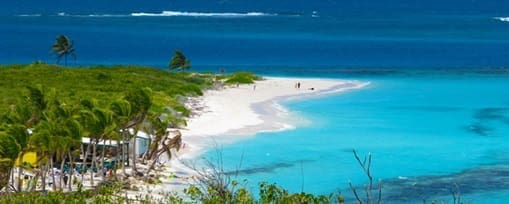INTRODUCTION
Anguilla is located in the British West Indies, approximately 6 miles from St. Martin in the Eastern Caribbean. It is bare and flat and is fringed by white sandy beaches. The name Anguilla is from the Italian anguilla, meaning “eel” in reference to the island’s shape. The majority of the population of Anguilla is of African descent. English is the official language. The territory’s capital is The Valley which is the principal town and the administrative centre of the island. Anguilla was formed from coral and limestone. The land is fairly flat but undulating. Noted for its easy-going atmosphere and magnificent beaches and waters, Anguilla is a popular tourist destination. The main economic activities revolve around tourism and financial services.
HISTORY
Anguilla was first settled by Indigenous Amerindian peoples who migrated from South America. Long before the arrival of Christopher Columbus in the Caribbean, Anguilla had been settled by Arawakan-speaking Indians. It was colonized by British in 1650 settlers from Saint Kitts and since then remained a British territory. During the latter part of the 17th century, the poor yield from tobacco (the island’s principal cash crop) and from cotton created economic hardship. Sugar, which yielded better returns than tobacco or cotton, transformed an economy made up primarily of European small farmers into one in which the labouring class. In 1824 the government of Great Britain created a new administrative plan for their territories in the Caribbean, which placed Anguilla under the administrative authority of Saint Kitts. The conflict between Saint Kitts and Anguilla would not be resolved until the twentieth century. Since 1980 Anguilla has prospered as a separate dependent territory. With an overall increase in economic prosperity and the end of conflict with Saint Kitts, Anguillans are today optimistic about their future.
TRADITIONAL DRESS
The traditional dress of the people of Anguilla is similar to that of any other Caribbean island. Female dress consists of sleeveless blouse that is made from either white polyester-cotton fabric. It has a two-layered collar with either green or red ribbon. The Neck is elasticated which can be worn on or off the shoulder. Below is an ankle length skirt, again trimmed with lace and red ribbons; which has two gathers towards the lower end of the garment. Then there’s an overskirt. overskirt are approximately knee-length which is made of madras fabric. The Madras material is used again in the fourth item, the head piece. It is a square or rectangular piece of cloth worn over the forehead and folded to display varying numbers of peaks. Around the waist is a waist sash which generally red or green in colour

References
https://www.britannica.com/place/Anguilla-island-West-Indies
https://en.wikipedia.org/wiki/Anguilla
http://kwekudee-tripdownmemorylaneyou.blogspot.com/2014/05/anguilla-island-caribbean-people-of.html

